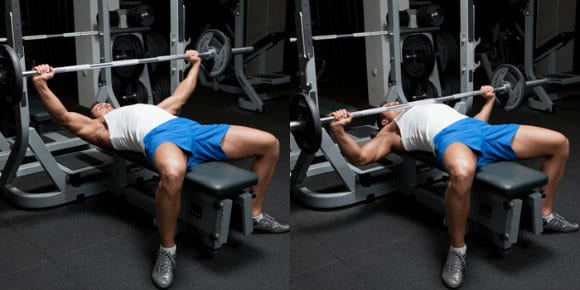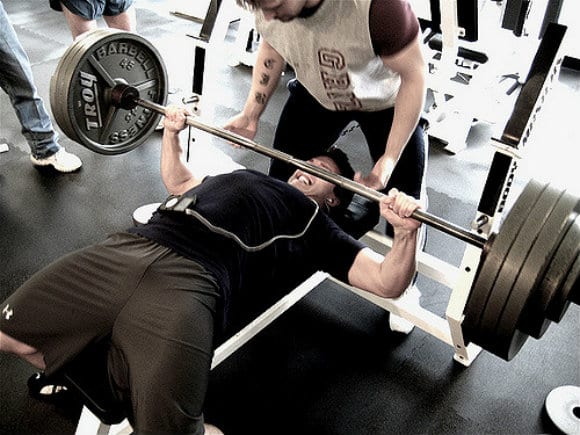Wide Press
It's six in the morning on any Monday. The sun rises on gyms all over the world.
It's - Monday - international bench press day: the day when, after the weekend, all the men (and some women) flock to the gyms to train the chest.
Bodybuilder, powerlifter, beginner, professional. It doesn't matter which category you belong to: on Mondays, you know very well what awaits you.
Throughout the day, it will be almost impossible to find a free bench anywhere.
By XNUMXpm this Monday all the pecs, anterior delts and triceps in the world will be sore from the incalculable number of flat and incline bench presses, barbell and dumbbell presses, push ups, dips, crosses, and who knows. what other targeted chest exercises.
How is it done?
However, as beginners often do or, in general, those who train with little attention, "bench pressing" does not only mean lying down, holding the well loaded barbell, and pushing: on the contrary.
Use your whole body to generate strength, and calculating the numerous details that make up the movement are the factors that can lead us to an excellent technical execution and, definitely not secondary, to move more weight.
One of the things to consider when doing the barbell bench press is the width of the grip.
The distance between the hands on the barbell, in fact, affects the elements of the musculature that are directed in the movement, allowing us to obtain different results.

While the execution of the movement remains almost identical, in bench press with a barbell the grip can be roughly divided into normal, narrow, and wide.
If the tight grip makes the triceps work more, simply moving the position of the hands slightly more outside than we normally hold the barbell - towards the discs, therefore - has considerable effects on the portions of the pectorals involved: the bands will be significantly more activated. superior and external ones, compared to distension with normal grip.
Pectoralis major activity is stimulated much more than with the incline bench or push-ups.
Not only. The opening of the arms - with the barbell in the low position, the forearms will not be perpendicular to the ground - causes the range of motion possible to be shorter and that, by increasing the tension on the shoulder joint, to lift the weight they are involved more muscle fibers.
This mechanism translates into the slightly higher percentage of weight that the wide grip stretch allows us to lift. It is a small percentage - we are around 5-7% - but it is there.
This is the main reason why the wide grip press has been present in the training routines of many powerlifters specialized in the bench press for decades.
Long Dam
It therefore becomes a question of goals.
If we want to use the flat bench for hypertrophy of the triceps, for example, the wide grip - reducing its activation - will not do for us.
If we want to activate the chest more, or lift more weight, then it will be interesting to add it to our workouts, perhaps after normal-grip stretches.
There is however one main caveat, especially if we are beginners. During wide-grip presses, the forces on the anterior deltoid and, therefore, on the shoulder joint are one and a half times greater than those involved during normal-grip presses.
That's why the wide-grip variant is considered risky. It is advisable, while running, to move the weight with absolute control in every phase of the movement, and to stop in the descent at five / ten centimeters from the chest.
As always, we must keep in mind not only our goals - and the exaltation of the moment - but also the physical sensations during exercise, and the history of our body: a shoulder that tends to go badly will bear this movement!

Common mistakes
After all, there is no shortage of exercises aimed at the pectoralis major and its external bands: we can safely give up this variant, if we sense the possible negative consequences.
Some other points to keep in mind when running: we don't make the classic mistake of pushing the elbows out.
We do not even exaggerate with the width of the grip, because the technical execution would suffer: "wide grip", therefore, is considered as "a little more than the width of the elbows". Eventually, we can try to push ourselves as far as the shoulders do not bother us during the execution.
In addition to strength training, the wide-grip distension can also be useful in the hypertrophy phase: for a complete development of the muscles of the chest, we recommend different combinations of grip of the barbell, and inclination of the bench.
From this point of view, the wide-grip press is a great supplemental exercise.
Conclusions
In summary, the wide-grip flat bench press seems to have equal proportions of supporters and detractors. The benefits are there, it is undeniable: those who include this wide-ranging movement in their training routines say it, and scientific studies say it.
Ma these benefits don't come without possible risks.
Ultimately, we recommend that you start using this variant of the flat bench press only when you are completely comfortable with normal-setting stress relief.
At the first signs of discomfort behind us, let us suspend it and, if we are not professional powerlifters, let us also allow ourselves to exclude it from our training regime.


























